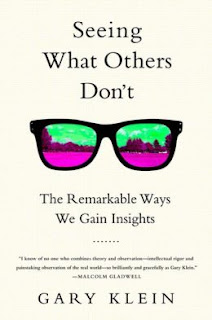 the government as a research psychologist for the U.S. Air Force. The third phase, in private industry, started in 1978 when he founded Klein Associates, a research and development company that had grown to thirty-seven employees by the time he sold it in 2005. He is the author of Sources of Power: How People Make Decisions; The Power of Intuition; Working Minds: A Practitioner's Guide to Cognitive Task Analysis (with Beth Crandall and Robert Hoffman); and Streetlights and Shadows: Searching for the Keys to Adaptive Decision Making.
the government as a research psychologist for the U.S. Air Force. The third phase, in private industry, started in 1978 when he founded Klein Associates, a research and development company that had grown to thirty-seven employees by the time he sold it in 2005. He is the author of Sources of Power: How People Make Decisions; The Power of Intuition; Working Minds: A Practitioner's Guide to Cognitive Task Analysis (with Beth Crandall and Robert Hoffman); and Streetlights and Shadows: Searching for the Keys to Adaptive Decision Making.Klein applied the “Page 99 Test” to his latest book, Seeing What Others Don't: The Remarkable Ways We Gain Insights, and reported the following:
I accepted the challenge to perform the page 99 test – open my new book Seeing What Others Don’t to page 99 and see what that page tells about the entire book. Then I got a bit nervous because I hadn’t checked to see what was on page 99.Learn more about Seeing What Others Don't at the publisher's website.
As it turns out, page 99 is a wonderful description of the book. The page starts a new section titled “Looking at the Stories.” This section falls within a chapter that describes different ways I tried to understand how we gain insights.
First, I examined the data I had collected from 120 actual incidents in which people arrived at insights. I had started with the formal coding I had performed on the data. I had derived 14 different categories and coded each incident on all 14. This approach produced some useful findings, but nothing exceptional.
Next I looked at the scientific literature on insight. Again, some nice information but mostly disappointment. The insight researchers had restricted their studies to simple tasks they could perform in a laboratory in an hour; these restrictions didn’t fit the kinds of incidents I had assembled.
Finally, I plunged into the 120 incidents themselves to see what I could learn. This is the section “Looking at the Stories” that begins on page 99. And here I hit paydirt. I discovered what the laboratory studies had been missing. I uncovered several different pathways for attaining insights.
The strategy of looking directly at the stories of how insights appeared isn’t as controlled as laboratory studies. You can’t define in advance how you’ll be running statistics. But what you get is the opportunity to make discoveries – to learn things from the stories that you hadn’t previously imagined.
Here is what I had to say about the story method on page 99:Naturalistic methods can be a bit nerve-wracking because you never know what you are looking for. You sift through the stories, on the lookout for patterns that might be meaningful. When you do laboratory studies in psychology you define in advance what data you’re going to collect, what hypotheses you’re going to test, what statistics you’re going to use. But the story-based strategy leaves all of that open. You can’t define in advance how you are going to analyze your data because you don’t know what patterns might emerge. Reviewing the stories is scary and exciting.
The incident-based method is well-suited for the early stages of science in which you try to explore some phenomenon. I hoped to find some answers in the 120 stories of insights.
--Marshal Zeringue